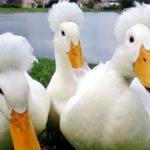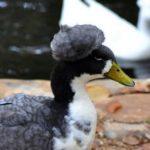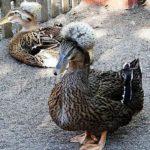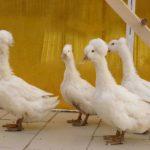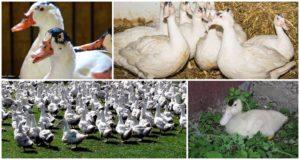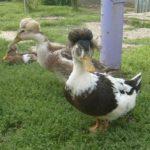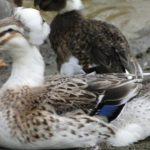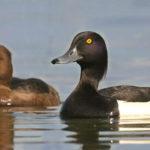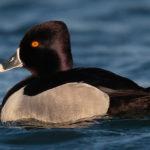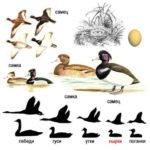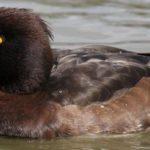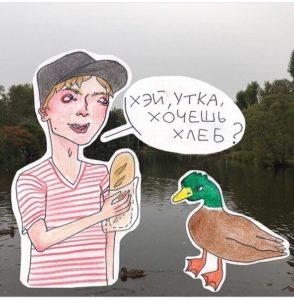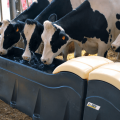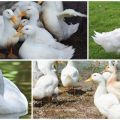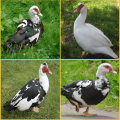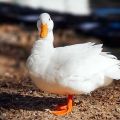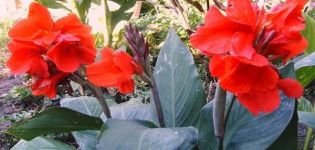Names and descriptions of black and white ducks with a tufted head and how to choose
Common ducks have smooth and short feathers on their heads. But there are breeds of black and white ducks with a tuft. The decoration gives the birds an unusual look, they immediately stand out from the rest, for which they are appreciated by poultry farmers. Consider the description and characteristics inherent in breeds, their pros and cons, how to properly maintain, how to feed, how to breed crested ducks.
Breeds of black and white ducks with a tufted head
The appearance of crested breeds dates back to the 17-18th century. In their genus, local breeds without the presence of a crest and crested ducks. They can be classified as a separate group called the Crested Duck. It includes several breeds, with differences in characteristics, but with a common feature - a lush crest on the head. The plumage color of crested ducks is different, depending on the color of the breeds that took part in the breeding. But there is a certain pattern - if the feathers are dark, then the color of the legs and beak is dark.
Russian crested
The duck has a light, squat body, slightly raised, well muscled. The bird's head is round-elongated, the neck is short and curved. The back is wide, lowered to the tail, a voluminous belly. The feather is thick, adjacent to the body. The crest is large, lush, consists of long narrow feathers, lighter than the general plumage.
The color of the ducks is white, black-and-white, multi-colored, orange legs.
Ukrainian Corydalis
The color of the Ukrainian crested is brownish-gray, pure white, brownish. White ducks have a stripe of a different shade on their necks. On the chest, back, sides, feathers of a characteristic wild color, like a mallard. There are 2 dark stripes on the sides of the head.
The weight, constitution, characteristics and productivity of the Ukrainian crested are the same as those of the Russians.
Bashkir crested
The body is strong, muscular, with a convex chest, a short neck, and legs with large fins.
Bashkir ducks have white and white-black color, khaki plumage with a pattern, like wild ducks.
Crested duck
It is a wild duck with white and black plumage, which is common in Russia and Europe. Birds have a stocky build, drakes weigh 0.8-1.2 kg, ducks - 0.7-1.1 kg.
The colors of the drakes are white belly, sides and chest, head, neck, back and tail are black. On the wings, shoulders and back on the feathers, you can see white specks. On the wings there is a wide white stripe with a black border. The legs are black. The females of the crested duke are dark brown, with a white feather on their belly, and a dark gray beak.
How to choose?
When choosing the best representative of any breed, you need to pay attention to the correct build, healthy appearance, purity of plumage and pattern. Ducklings must be properly developed, large, have good appetite and activity. Adult ducks should exhibit breed characteristics and show good egg production.
Pros and cons
Crested ducks are not raised on industrial farms, but are kept in private yards as exotic rare breeds. They are not interesting for production, because the average weight of a drake is 3 kg, ducks - 2-2.5 kg, and egg production is 55-60 eggs, the weight of which is not more than 80 g.
Features of the content
Wild ancestors passed on unpretentiousness to domestic crested ducks. They are omnivorous, undemanding to the content. Birds can be kept in outdoor pens, but it is better if they live free-range. On the pond, crested beetles can find food in such a volume that they do not have to be fed. If there is no reservoir nearby, ducks are fed soft grass, grain - crushed or sprouted.
Care rules: placement of no more than 4 birds per 1 sq. m, cleaning of straw or peat bedding, cleaning and disinfection of feeders and drinkers. Daily ventilation of the room and lighting in winter for 10-12 hours.

Corydalis breeding at home
The crested gene is not inherited by all ducklings. If one of the parents is without a tuft, then the ducklings will be ordinary. To obtain ducks with a characteristic feature, you need to select crested birds, both females and males. And not in one, but in several next generations. But even in this case, the appearance of ordinary ducklings is possible.
You can hatch chicks in an incubator or under a brood hen. The female can hatch 12-15 eggs.
Egg production and procreation
Corydalis can lay 60 eggs per season. If you keep a drake with ducks, you can use them for breeding. Usually all eggs are fertilized, the ducklings hatch well. The resilience and disease resistance inherent in wild ducks allows them to survive even in adverse conditions. With natural breeding, females themselves take care of the offspring and save it without loss. When hatching in an incubator, ducklings are raised in a brooder, and when they reach the age of one month, they are transferred to the poultry house.
Crested ducks are not raised as beef and egg ducks, not for profit. Their value lies in their decorative appearance and bright plumage. As a decorative bird, the corydalis is kept in private houses to decorate the courtyard. Despite the low productivity and rarity, enthusiastic poultry breeders try to preserve the breed and maintain interest in them.

